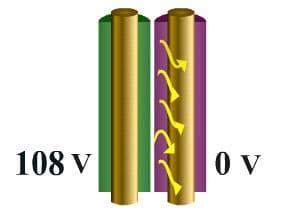Capacitance and Cable Testing
What is Capacitance?
Watch the video
Any two conductors separated by a distance can store a charge. So any two wires in a cable or harness can store a charge. This stored charge can affect how the cable behaves during testing.
The term “capacitance” describes the ability of two conductors (separated by insulation) to store a charge. Capacitance is affected by the distance between the conductors and the insulation around the conductors. As the conductors get closer together or have more surface area (longer wires, shields etc.), the capacitance will increase.
The formula: Q=CV describes how the charge (Q), capacitance (C), and voltage (V) interact. When the voltage is zero the charge will be zero (if V=0, then Q=0). If you double the voltage (V), you will double the charge (Q).
It is sometimes useful to think in terms of current. The relationship between current, voltage, and capacitance is I = CdV/dt. This indicates that the current (I) in a capacitor is proportional to the rate of change of voltage (dV/dt) across the capacitor. If the voltage is going up, current must be flowing into the capacitor. If the voltage is going down current must be flowing out of the capacitor. And the faster the voltage changes, the higher the current.

When you test a cable, the wires behave like a capacitor. This capacitance becomes especially important during a hipot test when high voltage is applied between two wires. The higher the voltage and capacitance the higher the charge and the higher the energy. At some point this electrical energy becomes dangerous. When the hipot test is completed the energy in the wires will be safely discharged, bringing the voltage back to zero and removing the risk of shock. But if someone were to touch the assembly while being tested, this energy would be discharged into them.
For an AC test, more energy than in a DC test is used to constantly change the voltage. Frequency effects on the heart and the higher energy required causes AC tests to be hazardous at lower voltages and capacitances than DC tests.
Cirris testers such at the Signature 1000H+/1100H+/Touch1 and CH+ are designed to limit energy to non-hazardous levels. When using test equipment that can provide hazardous electrical energy, special precautions to protect the operator are critical such as palm switches, light curtains and shut off switches etc. Please contact us for solutions to both your hazardous and non-hazardous testing needs.

